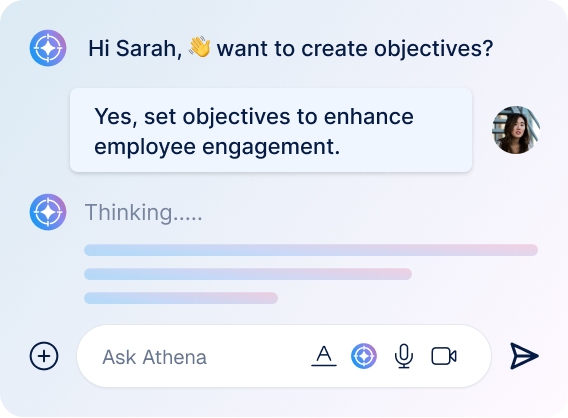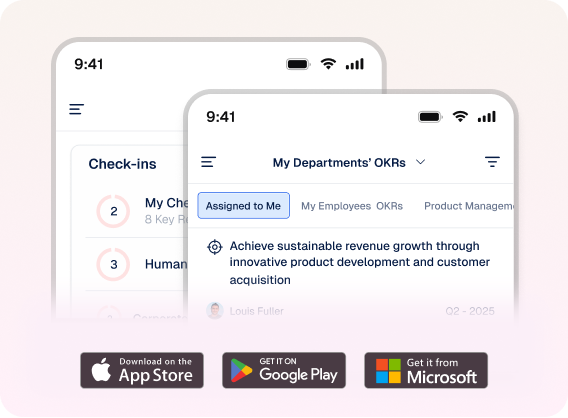“So… what are we trying to achieve?”
It’s a question we ask ourselves every quarter. A simple one, right? But if you’ve ever been in an OKR planning session, you know it can turn into an intense discussion one that challenges assumptions, uncovers blind spots, and, ultimately, brings clarity.
At Profit.co, OKR planning isn’t just about writing down objectives and key results. It’s a structured, high-impact process designed to align teams, prioritize the right goals, and ensure flawless execution.
And we don’t rush it. We dedicate two full days to OKR planning every quarter because getting it right at the start makes execution smoother, more efficient, and more meaningful.
Here’s how we do the OKR planning
Once a quarter, we step back from the daily whirlwind of tasks, emails, and messages to focus on something bigger: OKR Planning. This is the meeting where we don’t just talk about what needs to get done we define why it matters and how we’ll measure success.
If you fail to plan, you are planning to fail!
The Two-Day OKR Planning Process at Profit.co
We break OKR planning into three key stages over two days to ensure clarity, alignment, and commitment.

Day 1: Ideation and Alignment
Day 1 is about ideation and alignment. Think of it as the OKR equivalent of laying down the foundation before building a house. Skip this part, and everything else gets shaky real fast.
Step 1: Objective Ideation – Defining the “Why”
Every great OKR starts with a well-defined objective. Before we set key results, we step back and get clear on the “why”. Without it, execution turns into a guessing game, and goals lose their meaning.
So, we ask ourselves:
- What do we want to achieve? If an objective doesn’t excite us, we rethink it. Because if it doesn’t inspire action, it won’t drive results. OKRs should spark momentum, not feel like a to-do list.
- What’s the outcome of being successful? Vague goals lead to vague results. We need to define what success actually looks like. What will change if we nail this objective? How will we know we’ve won?
- Who do we need to involve?
- What roadblocks might slow us down? Every big goal comes with hurdles. The sooner we identify them, the sooner we can tackle them before they turn into execution nightmares.
- What additional support do we need? Ambition alone isn’t enough. Do we have the budget, the tools, the people to make this happen? If not, how do we close that gap? Success isn’t just about effort it’s about being equipped for the journey.
The best execution happens when the right people are in the room. Collaboration fuels momentum, and every objective needs clear ownership to avoid getting lost in the shuffle.
At this stage, we’re in big-idea mode brainstorming, debating, and stress-testing our thinking. Group discussions, breakout sessions, sticky notes on whiteboards it all happens here. The goal? To refine objectives that actually matter, not just sound good on paper.
And once we’re aligned on the why, we move to the next step: figuring out how to measure it.
Step 2: Key Results Ideation – Measuring What Matters
OKRs are like road trips. The objective is your destination the exciting place you want to reach. But without key results, you have no map, no GPS, no way to know if you’re actually getting there… or just driving in circles.
That’s why this step is all about turning goals into measurable outcomes. We’re not here for vague aspirations. We’re here to track progress in a way that’s clear, actionable, and most importantly meaningful.
So, before we start setting numbers, we ask ourselves:
- How do we ensure we’re making progress?
- What kind of measures should we track?
- Where do we stand today, and where do we want to go?
- What’s the industry benchmark?
Because nothing kills motivation faster than working hard with no sense of movement. Measuring incremental wins keeps the momentum high and the team engaged.
Spoiler: “Work harder” is not a key result. We need numbers, not just narratives. What data will tell us we’re moving in the right direction?
Every key result needs a starting point and a finish line. Otherwise, how do we know if we’ve improved or if we’re just running in place?
Because we don’t just want progress we want meaningful progress. Setting ambitious yet achievable targets keeps us competitive and ensures we’re not just celebrating mediocrity.
This is where data meets ambition where we define the right metrics to push teams forward while keeping them grounded in reality.
By the end of Day 1, we have a set of well-structured objectives and potential key results that need refining and prioritization. And once we’ve nailed the right metrics, we move on to the next step: Finalizing OKRs and making them execution-ready
Before you can execute your OKRs, you need to get crystal clear on the ‘what’ and the ‘why.’ Because great execution starts with great planning.Tweet
Day 2: Prioritization and Commitment
Alright, we made it through Day 1. We’ve brainstormed, debated, and maybe even had a few “Wait… is that really an OKR?” moments. But now, we’re staring at a long list of potential objectives and key results, and let’s be real we can’t do everything.
So, Day 2 is all about focus. It’s time to trim the fat, filter out the fluff, and zero in on the OKRs that truly matter. The ones that will drive impact, move the needle, and (let’s be honest) actually get done.
This is where we shift from big ideas to bold commitments. No more “nice-to-haves” just high-priority, high-impact OKRs that the team is ready to own.
Step 3: Finalizing OKRs – Committing to the Right Goals
Now comes the tough part: making choices. Because let’s be real if everything is a priority, then nothing is. Day 2 is all about focus and feasibility. It’s where we shift from big ideas to bold commitments. This is where we make sure our OKRs are not just ambitious, but also achievable.
So, we get ruthless:
- We prioritize the top 3–5 objectives. More than that? We risk losing focus and stretching ourselves too thin.
- We refine key results, keeping 3–5 per objective. Too many? We rethink what actually matters because cluttered OKRs don’t drive action, they create confusion.
- Then comes the moment of truth OKR Confidence Voting. Before locking things in, we gut-check:
- Does the team believe in these goals? Because if no one’s excited, execution is going to be a slog.
- Can they realistically achieve them with effort? Stretch goals? Yes. Impossible goals? Nope.
- Do they have the right resources to execute? If not, we either fix that now or adjust expectations.
This final step ensures buy-in, alignment, and motivation because OKRs only work when teams fully commit to them. No wishful thinking, no “set it and forget it.” And once we have that commitment? We’re locked in. It’s go time.
Want to make OKR planning effortless?
Why This Works at Profit.co
At Profit.co, we’ve seen firsthand that great execution starts with great planning. Our structured two-day process ensures that:
- Objectives are meaningful and aligned with company priorities.
- Key results are measurable and push us toward real growth.
- Teams are committed, equipped, and confident in their goals.
Because OKR planning isn’t just about setting goals it’s about setting the right goals. And when done right, it transforms execution, accountability, and impact.

So, What’s Next?
- OKR planning? Done.
- Big, bold objectives? Locked in.
- Clear, measurable key results? Nailed it.
Now comes the real work: making sure these OKRs don’t just live in a slide deck, forgotten by next Tuesday.
Here’s how we keep them front and center not just words, but action:
- We set it all up in the Profit.co OKR tool. No spreadsheets, no lost documents just a clean, trackable system where every objective, key result, and owner is crystal clear.
- We assign ownership. Because when everyone owns a piece of the goal, accountability happens naturally. (No more “I thought someone else was handling that” moments.)
- We set up check-ins. Weekly or bi-weekly updates in Profit.co ensure progress is steady, blockers get addressed, and we don’t suddenly realize, “Oh wait, we haven’t looked at these OKRs in a month.”
- We adapt when needed. Things change. Priorities shift. But instead of forcing an outdated plan, we track and adjust in real-time so our OKRs stay relevant, not rigid.
At Profit.co, we believe OKRs aren’t just a planning exercise. They’re a living, breathing system for driving results. And the real magic happens not just in setting goals but in actually achieving them.So now, we move from planning to execution. And as we do, we ask ourselves:
“Are we just tracking goals, or are we actually making things happen?”
FAQs
- How do we ensure OKRs don’t just sit in a document and get ignored?
- What if priorities shift mid-quarter?
- Do OKRs replace KPIs?
- What’s the best way to get buy-in for OKRs?
We live inside the Profit.co OKR tool. Everything is tracked, updated, and reviewed consistently no more “set it and forget it” goals.
They always do. That’s why we check in regularly and adjust if needed because rigid OKRs don’t work in a fast-moving environment.
Nope! KPIs track performance; OKRs drive change. Think of OKRs as the strategic levers you pull to improve KPIs.
Make sure the team understands the “why.” If OKRs feel like extra work instead of a tool for success, they won’t stick. That’s why we prioritize OKR Confidence Voting before finalizing anything because goals work best when everyone’s all in.




